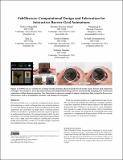FabObscura: Computational Design and Fabrication for Interactive Barrier-Grid Animations
Author(s)
Sethapakdi, Ticha; Perroni-Scharf, Maxine; Li, Mingming; Li, Jiaji; Solomon, Justin; Satyanarayan, Arvind; Mueller, Stefanie; ... Show more Show less
Download3746059.3747629.pdf (1.970Mb)
Publisher with Creative Commons License
Publisher with Creative Commons License
Creative Commons Attribution
Terms of use
Metadata
Show full item recordAbstract
We present FabObscura: a system for creating interactive barrier-grid animations, a classic technique that uses occlusion patterns to create the illusion of motion. Whereas traditional barrier-grid animations are constrained to simple linear occlusion patterns, FabObscura introduces a parameterization that represents patterns as mathematical functions. Our parameterization offers two key advantages over existing barrier-grid animation design methods: first, it has a high expressive ceiling by enabling the systematic design of novel patterns; second, it is versatile enough to represent all established forms of barrier-grid animations.
Using this parameterization, our computational design tool enables an end-to-end workflow for authoring, visualizing, and fabricating these animations without domain expertise. Our applications demonstrate how FabObscura can be used to create animations that respond to a range of user interactions, such as translations, rotations, and changes in viewpoint. By formalizing barrier-grid animation as a computational design material, FabObscura extends its expressiveness as an interactive medium.
Date issued
2025-09-27Department
Massachusetts Institute of Technology. Computer Science and Artificial Intelligence LaboratoryPublisher
ACM|The 38th Annual ACM Symposium on User Interface Software and Technology
Citation
Ticha Sethapakdi, Maxine Perroni-Scharf, Mingming Li, Jiaji Li, Justin Solomon, Arvind Satyanarayan, and Stefanie Mueller. 2025. FabObscura: Computational Design and Fabrication for Interactive Barrier-Grid Animations. In Proceedings of the 38th Annual ACM Symposium on User Interface Software and Technology (UIST '25). Association for Computing Machinery, New York, NY, USA, Article 109, 1–16.
Version: Final published version
ISBN
979-8-4007-2037-6